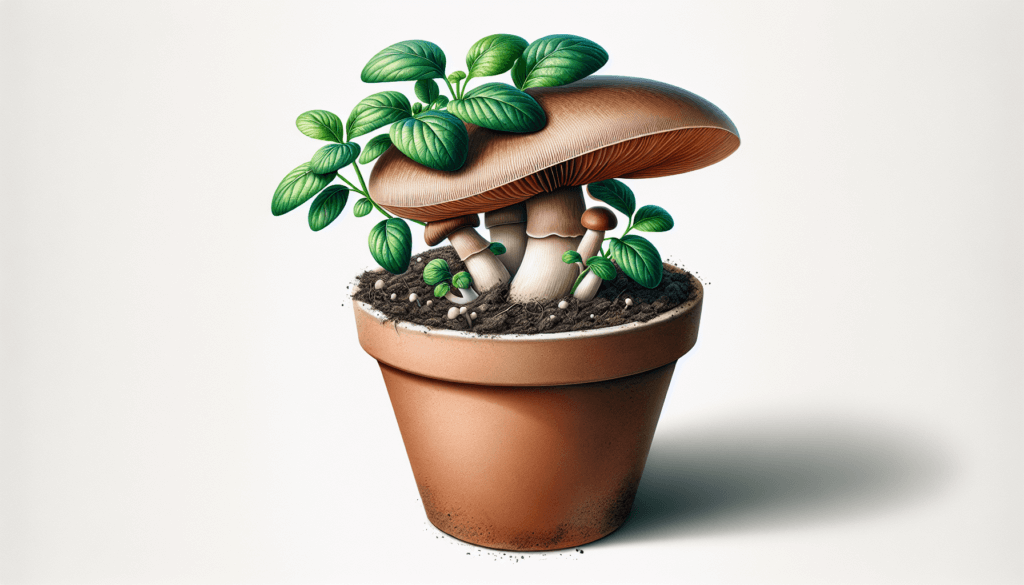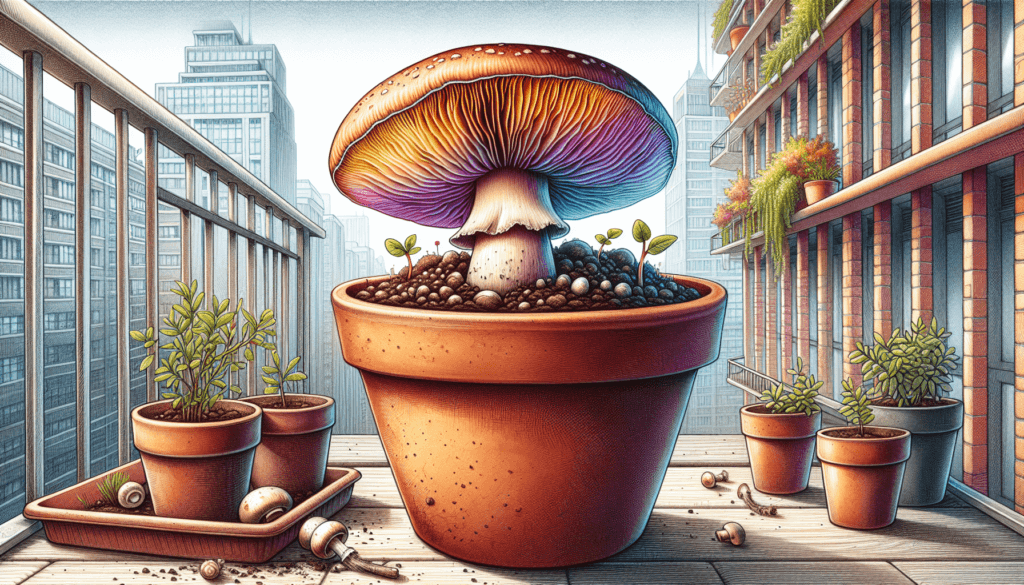Are you a passionate urban gardener looking to add a touch of magic to your green oasis? Look no further! In this article, we will explore the fascinating world of DIY edible mushroom growing specifically designed for urban gardeners. Discover how you can cultivate these delectable fungi right in your own backyard, balcony, or even indoor space. With some simple techniques and a little bit of patience, you’ll soon be enjoying the thrill of harvesting your very own homegrown mushrooms. Get ready to bring a new level of freshness and flavor to your culinary adventures!

Choosing the Right Mushrooms
When it comes to growing mushrooms in your own urban garden, there are a few factors to consider in order to choose the right mushrooms for your space. One important factor is the available space you have for cultivating mushrooms. Different mushroom varieties require different amounts of space, so it’s essential to take this into account before making your selection. Additionally, you need to identify suitable mushroom varieties that will thrive in your specific growing conditions. Some mushrooms require specific environments or temperature ranges, so it’s important to choose varieties that align with your capabilities as a grower. By considering both space and variety, you can set yourself up for success in your mushroom-growing endeavor.
Considering Available Space
The first step in choosing the right mushrooms for your urban garden is taking a close look at the available space you have. If you have limited space, you may want to opt for mushrooms that can be grown vertically, such as oyster mushrooms. These varieties can be cultivated on vertical surfaces or in small containers, making them ideal for urban gardens with limited square footage. If you have more space available, you can consider growing mushrooms that require larger growing areas, such as shiitake mushrooms. By accurately assessing your space, you can determine which mushrooms are the best fit for your urban garden.

Identifying Suitable Mushroom Varieties
Once you have considered the available space in your urban garden, it’s time to identify suitable mushroom varieties that will thrive in your specific growing conditions. Some popular mushroom varieties for urban gardens include oyster mushrooms, shiitake mushrooms, and white button mushrooms. Oyster mushrooms are known for their versatility and ease of cultivation, making them an excellent choice for beginners. Shiitake mushrooms require a bit more attention but are highly prized for their rich flavor. White button mushrooms are a classic choice and can be grown indoors or outdoors. By researching and identifying suitable mushroom varieties, you can ensure a successful cultivation experience.
Understanding Mushroom Growing Requirements
Before embarking on your mushroom-growing journey, it’s crucial to understand the specific requirements that mushrooms have in order to grow successfully. Mushrooms have unique growing conditions that vary depending on the variety. Generally, mushrooms require a growing environment with appropriate temperature and humidity levels, proper lighting, and adequate air circulation. Additionally, mushrooms rely on specific substrates or growing mediums to thrive. For example, oyster mushrooms can grow on a variety of substrates, including straw, coffee grounds, or sawdust. Shiitake mushrooms, on the other hand, prefer hardwood logs as their substrate. By understanding the specific requirements of the mushroom varieties you choose, you can create the ideal growing environment for them.

Preparing the Growing Environment
Once you have selected the right mushrooms for your urban garden, it’s time to prepare the growing environment. This involves creating a designated mushroom growing area, selecting suitable containers, and preparing the substrate.
Creating a Mushroom Growing Area
To ensure successful mushroom cultivation, it’s important to dedicate a specific area in your urban garden solely for mushroom growing. This area should be clean, well-ventilated, and protected from extreme weather conditions. Consider setting up a designated shelf or table for growing containers, or even repurposing a small corner of your backyard. By creating a dedicated mushroom growing area, you can provide the optimal conditions necessary for healthy mushroom growth.
Selecting Suitable Containers
Choosing the right containers for your mushroom cultivation is crucial for their well-being. Depending on the mushroom variety you are growing, different types of containers may be required. For example, oyster mushrooms can be grown in plastic bags or small trays, while shiitake mushrooms often thrive in wooden logs. Ensure that the containers are clean and have adequate drainage to prevent waterlogging, which can lead to rot or mold. Consider the specific needs of your chosen mushroom varieties when selecting containers for optimal growing conditions.
Preparing the Substrate
The substrate, or the material on which mushrooms grow, is an essential component of mushroom cultivation. The type of substrate needed will vary depending on the mushroom variety you have chosen. Oyster mushrooms, for example, can be grown on a variety of substrates, such as straw, coffee grounds, or sawdust. Shiitake mushrooms, on the other hand, require hardwood logs as their substrate. Before you begin growing your mushrooms, ensure that the substrate is properly prepared according to the specific requirements of your chosen mushroom variety. This may involve sterilizing the substrate or pasteurizing it to eliminate competing organisms. By properly preparing the substrate, you are setting the stage for successful mushroom growth.
Starting with Mushroom Spawn
Once you have prepared the growing environment, it’s time to obtain the necessary mushroom spawn to begin your cultivation process. Understanding mushroom spawn, whether you choose to buy it or make your own, and preparing it for inoculation are important steps in starting your mushroom-growing journey.
Understanding Mushroom Spawn
Mushroom spawn can be thought of as the “seed” from which mushrooms grow. It consists of a substrate that has been inoculated with mushroom mycelium, the thread-like vegetative part of the fungus. Mushroom spawn provides the essential nutrients and conditions necessary for the mycelium to grow and produce mushrooms. Understanding the role of mushroom spawn is key to successful mushroom cultivation.
Buying or Making Your Own Spawn
There are two main options when it comes to obtaining mushroom spawn: buying it or making your own. Many specialized stores and online retailers offer a wide variety of mushroom spawn to choose from. When purchasing spawn, ensure that it matches the specific mushroom variety you plan to grow. Alternatively, if you prefer a more hands-on approach, you can make your own spawn by expanding a small amount of commercial spawn on a larger substrate. This process allows you to increase the volume of mushroom spawn for subsequent inoculations. Whichever method you choose, having a readily available supply of mushroom spawn is essential for your cultivation journey.
Preparing the Spawn for Inoculation
Before you can inoculate the substrate with mushroom spawn, it’s important to prepare the spawn for planting. This involves breaking up the spawn into smaller pieces and ensuring its uniform distribution. Depending on the mushroom variety, the spawn may need to be mixed with the substrate or placed strategically within it. Take care to follow the specific instructions for your chosen mushroom variety to ensure proper colonization and subsequent fruiting. By properly preparing the spawn for inoculation, you are maximizing the chances of successful mushroom growth.

Inoculating the Substrate
Once the spawn is prepared, it’s time to inoculate the substrate, providing the mycelium with a hospitable environment to grow and develop.
Choosing the Inoculation Method
There are several methods for inoculating the substrate with mushroom spawn, and the method you choose will depend on your personal preference and the specific requirements of your chosen mushroom variety. Common methods include mixing the spawn and substrate together thoroughly, layering the spawn and substrate in a container, or placing the spawn strategically in holes or channels within the substrate. Research the recommended inoculation method for your chosen mushroom variety to ensure successful colonization.
Preparing the Substrate for Inoculation
Before inoculation, it’s important to prepare the substrate to create an optimal environment for the mycelium to colonize. This may involve pasteurizing or sterilizing the substrate to eliminate competing organisms, depending on the requirements of your chosen mushroom variety. Follow the recommended preparation method for your specific substrate to ensure the best chances of successful inoculation and subsequent fruiting.
Inoculating the Substrate with Mushroom Spawn
Once the substrate is properly prepared, it’s time to inoculate it with the mushroom spawn. Depending on the inoculation method you have chosen, mix the spawn and substrate together thoroughly, layer them in a container, or strategically place the spawn within the substrate. Ensure that the spawn is evenly distributed throughout the substrate to encourage uniform colonization. By properly inoculating the substrate with mushroom spawn, you are setting the stage for vigorous mycelial growth and ultimately, mushroom production.
Providing the Ideal Growing Conditions
After inoculating the substrate, it’s crucial to provide the ideal growing conditions for your mushrooms to thrive. This involves maintaining proper temperature and humidity levels, arranging appropriate lighting, and ensuring adequate air circulation.
Maintaining Proper Temperature and Humidity
Mushrooms have specific temperature and humidity requirements for optimal growth. Different varieties have different preferences, so it’s important to research the specific needs of your chosen mushroom variety. Generally, mushrooms thrive in temperature ranges between 55°F to 75°F (12°C to 24°C) and humidity levels between 80-95%. You can use a thermometer and hygrometer to monitor the conditions in your growing area and make adjustments as necessary. Consider using a humidifier or mister to maintain the desired humidity level, and a heater or air conditioner for temperature regulation if needed. By closely monitoring and maintaining proper temperature and humidity, you are providing your mushrooms with the best chances of success.
Arranging Appropriate Lighting
While mushrooms do not require direct sunlight for growth, they do benefit from indirect or ambient light. Natural light from a nearby window or artificial light sources can provide the necessary illumination for your mushrooms. However, excessive light exposure can be harmful, so it’s important to strike a balance. If natural light is insufficient, consider using fluorescent or LED grow lights. These lights provide the necessary spectrum of light for mushroom growth without the excessive heat generated by traditional incandescent bulbs. Arrange the lighting in your growing area to ensure even distribution, and set a timer to mimic natural day-night cycles. By arranging appropriate lighting, you are promoting healthy mushroom growth and development.
Ensuring Adequate Air Circulation
Proper air circulation is essential for mushroom growth, as it helps maintain fresh oxygen supply and prevents the buildup of stale air or carbon dioxide. If your growing area lacks natural air movement, consider using a fan or installing an air circulation system to promote healthy mushroom development. Ensure that the air circulation system is not directly blowing on the mushrooms, as excessive air movement can potentially dry them out. By ensuring adequate air circulation, you are creating an environment conducive to robust mushroom growth.

Managing Mushroom Growth
Once your mushrooms have started to grow, it’s important to monitor and manage their development by keeping an eye on temperature and humidity, implementing watering and misting techniques, and preventing contamination and pest issues.
Monitoring and Adjusting Temperature and Humidity
Even after the initial setup of your growing environment, it’s crucial to continually monitor and adjust the temperature and humidity levels as your mushrooms grow. Different stages of mushroom development may require specific temperature or humidity adjustments. For example, during the fruiting stage, higher humidity levels are often necessary to encourage the formation of mushroom caps. Regularly check the temperature and humidity levels in your growing area and make any necessary adjustments to ensure optimal growing conditions throughout the entire mushroom growth cycle.
Watering and Misting Techniques
Proper watering and misting techniques are essential for maintaining moisture levels in your mushroom growing environment. While mushrooms thrive in high humidity environments, they should not be overly saturated with water. A fine misting with clean water or the careful application of water to the substrate is often sufficient to provide the necessary moisture. It’s important to strike a balance, as excessive moisture can lead to mold or rot. Regularly monitor the moisture levels in your growing environment and adjust your watering and misting techniques accordingly. By providing the ideal moisture levels, you are supporting healthy mushroom growth and preventing drying out or waterlogging.
Preventing Contamination and Pests
Contamination and pests can pose a threat to your mushroom crop. To prevent contamination, ensure that your growing area is clean and properly sterilized or pasteurized before starting the cultivation process. Avoid introducing foreign materials or organisms into your growing environment, and be mindful of good hygiene practices when handling your mushroom crop. Additionally, pests like flies or mites may be attracted to your mushrooms. Take preventative measures such as using screens or netting to keep pests out, or employing organic pest control methods if necessary. By diligently preventing contamination and pest issues, you can create a healthy and thriving mushroom garden.
Caring for Young Mushrooms
As your mushrooms continue to grow, it’s important to provide them with the care they need to reach maturity. Ensuring proper air and light exposure, maintaining optimum moisture levels, and identifying early signs of disease or issues are crucial for the successful cultivation of young mushrooms.
Ensuring Proper Air and Light Exposure
Young mushrooms need adequate air and light exposure to grow and develop properly. Proper air circulation helps prevent the buildup of excess carbon dioxide or stale air around the developing mushrooms. Ensure that your air circulation system is functioning optimally and not directly blowing on the young mushrooms. Additionally, monitor the lighting in your growing area to ensure that the mushrooms receive sufficient indirect or ambient light. Proper air and light exposure will contribute to healthy mushroom growth.
Maintaining Optimum Moisture Levels
Young mushrooms require specific moisture levels to thrive. While mushrooms appreciate high humidity, they should not be overly wet. Monitor the moisture levels in your growing area and adjust your watering and misting techniques accordingly. Avoid spraying water directly onto the young mushrooms, as this can damage or deform their delicate structures. Instead, ensure the substrate or growing medium maintains an even moisture content. By maintaining optimum moisture levels, you are supporting the healthy development of your young mushrooms.
Identifying Early Signs of Disease or Issues
As mushrooms grow, it’s important to regularly inspect them for any signs of disease or issues. Keep an eye out for discoloration, abnormal growth patterns, or signs of contamination. Be vigilant in identifying any changes in appearance or texture that may indicate a problem. Additionally, monitor the overall health and vitality of your mushrooms. If any issues are detected, take immediate action to address and remedy them. By proactively identifying and addressing early signs of disease or issues, you can prevent potential setbacks and ensure the continued growth and success of your mushroom crop.
Harvesting and Storage
The time will come when your mushrooms are ready to be harvested. Determining the right time to harvest, utilizing appropriate harvesting techniques for different mushroom types, and storing harvested mushrooms correctly are vital steps in the cultivation process.
Determining the Right Time to Harvest
Each mushroom variety has its own ideal harvesting time, which can be influenced by factors such as size, texture, and color. Consult a reliable resource or gardening guide to determine the optimal harvest time for your chosen mushroom variety. As a general rule, mushrooms should be harvested before the caps open fully and release their spores. By harvesting at the right time, you will yield the best flavor, texture, and overall quality from your mushrooms.
Harvesting Techniques for Different Mushroom Types
Different mushroom varieties require specific harvesting techniques to ensure minimal damage to the mushrooms and the growing medium. For example, oyster mushrooms can simply be cut at the base, while shiitake mushrooms require a twisting motion to detach them from the substrate. White button mushrooms can be gently pulled or cut from the growing medium, taking care not to disturb the surrounding area. Research the recommended harvesting techniques for your chosen mushroom variety to ensure a successful harvest.
Storing Harvested Mushrooms
Proper storage is essential to maximize the shelf life and flavor of your harvested mushrooms. After harvesting, gently brush off any excess dirt or debris and handle the mushrooms with care to avoid bruising or damaging them. Store mushrooms in a breathable container, such as a paper bag or a loosely closed paper towel, to allow for air circulation and prevent moisture buildup. Keep them refrigerated between 32°F to 45°F (0°C to 7°C) to maintain freshness. Avoid storing them in airtight plastic bags, as this can cause moisture buildup and lead to spoilage. By following these storage guidelines, you can extend the lifespan of your harvested mushrooms and enjoy them at their best.
Troubleshooting Common Issues
Even with proper care, occasionally issues may arise during the mushroom cultivation process. Being prepared to address common issues such as mold or fungus contamination, slow or stunted growth, and fruiting problems can help mitigate potential setbacks.
Dealing with Mold or Fungus Contamination
Mold or fungus contamination can occur if proper sterilization or pasteurization protocols were not followed or if the growing environment becomes contaminated. If you notice any signs of mold or fungus contamination, immediately remove the affected area or substrate to prevent further spread. Adjust your growing environment to eliminate the conditions favoring contamination, such as excessive moisture or poor air circulation. Additionally, ensure that you are using clean equipment and practicing good hygiene practices when handling your mushroom crop. By promptly addressing mold or fungus contamination, you can prevent its spread and protect your mushroom garden.
Addressing Slow or Stunted Growth
If you notice that your mushrooms are experiencing slow or stunted growth, it may be an indication of suboptimal growing conditions. Ensure that you are consistently maintaining the proper temperature, humidity, and lighting requirements for your chosen mushroom variety. Check that the substrate is adequately moisturized and that the air circulation is sufficient. If necessary, adjust any factors that may be hindering the growth of your mushrooms, such as excessive or insufficient moisture levels. By identifying and addressing potential issues, you can promote healthy and consistent mushroom growth.
Preventing Fruiting Problems
Fruiting problems, such as the failure of mushrooms to develop or low yields, can be frustrating for growers. To prevent fruiting problems, ensure that your mushrooms are receiving the proper environmental conditions, such as temperature, humidity, and lighting. Check that the substrate is adequately colonized with mycelium before expecting fruiting to occur. Additionally, avoid overwatering or underwatering, as this can cause fruiting problems. Regularly monitor and adjust the growing conditions to stimulate the formation of fruiting bodies. By implementing preventative measures and maintaining optimal growing conditions, you can increase the likelihood of successful and abundant mushroom fruiting.
Creative Uses for Homegrown Mushrooms
Once you have successfully cultivated your own mushrooms, exploring their culinary possibilities, utilizing them for natural dyes, or incorporating them into crafts can add another dimension to your growing experience.
Exploring Culinary Possibilities
Homegrown mushrooms offer a myriad of culinary possibilities. From sautéing them in butter and garlic or adding them to pasta dishes to creating flavorful mushroom soups and risottos, your homegrown mushrooms can elevate your culinary creations. Experimenting with different cooking techniques and recipes can help you unlock the full potential of your mushroom harvest. Consider exploring mushroom-based vegetarian or vegan recipes or even preserving them by drying or canning. The unique flavors and textures of homegrown mushrooms can provide endless inspiration for your culinary adventures.
Using Mushrooms for Natural Dyes
Mushrooms can be used to create natural dyes that can be used to color yarn, fabric, or even paper. Certain mushroom varieties, such as the vibrant deep purple-blue colors of the Indigo Milk Cap mushroom, can produce stunning natural dyes. Experiment with different mushroom species and extraction methods to create a diverse range of colors. From earthy browns and yellows to vivid blues and reds, the natural dyes derived from mushrooms can add a unique touch to your DIY projects or creative pursuits.
Utilizing Mushrooms in Crafts
Beyond their culinary and dyeing potential, mushrooms can also be incorporated into various crafts. The unique shapes, textures, and colors of dried mushrooms can be used to create captivating art pieces or decorative elements. You can incorporate them into handmade jewelry, terrariums, or even pressed flower artwork. The possibilities for using mushrooms in crafts are limited only by your imagination. Let your creativity run wild and explore the fascinating world of mushroom-inspired crafts.
In conclusion, growing mushrooms in your own urban garden can be a rewarding and enjoyable experience. By carefully choosing the right mushrooms for your space, understanding their growing requirements, and providing the ideal growing conditions, you can successfully cultivate homegrown mushrooms. With proper care and attention to detail, you can harvest your mushrooms at the optimal time, prevent common issues, and explore their culinary and creative possibilities. So roll up your sleeves, get ready to embark on a mushroom-growing adventure, and savor the satisfaction of growing your own delicious and unique mushrooms right at home.


